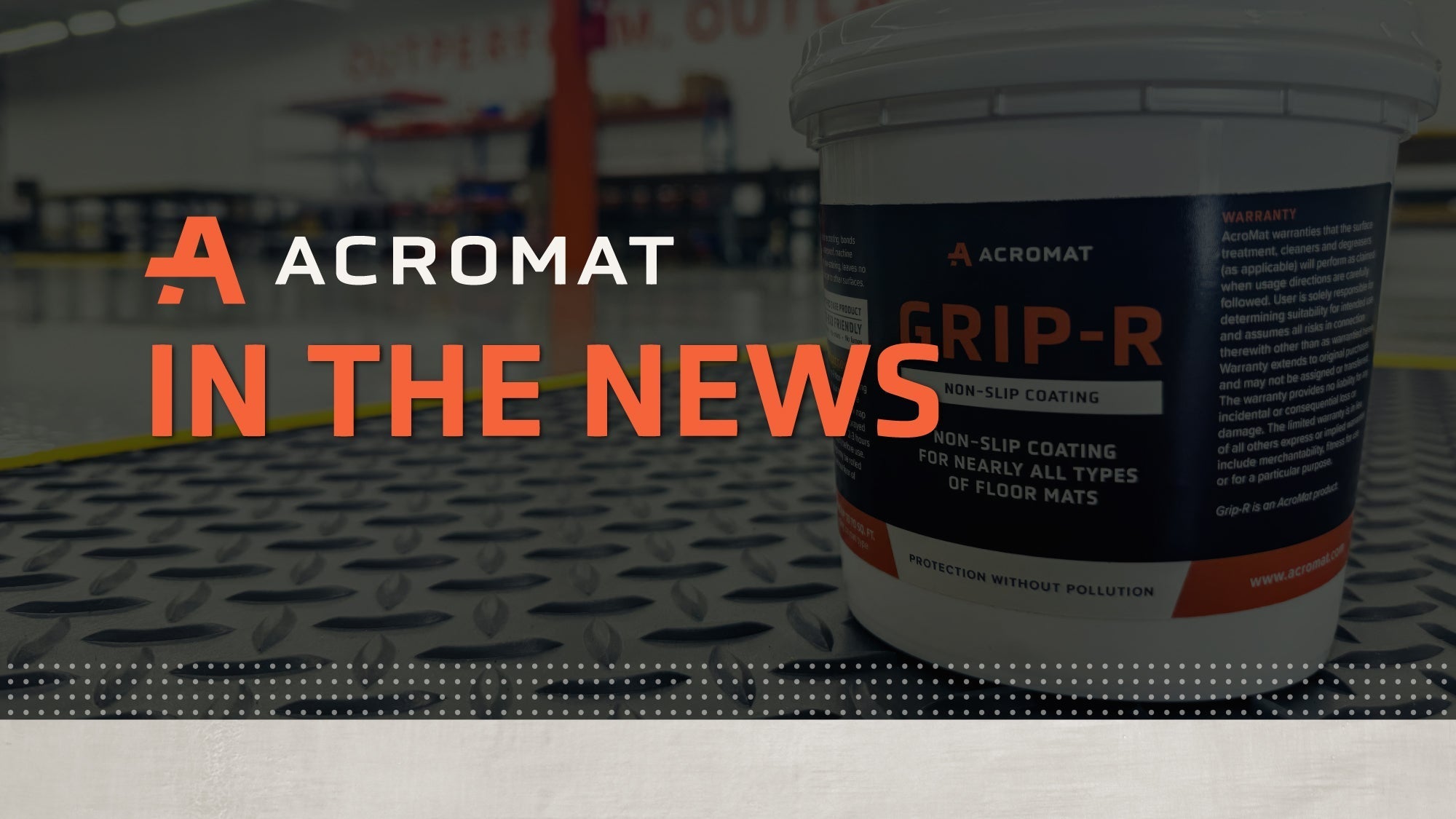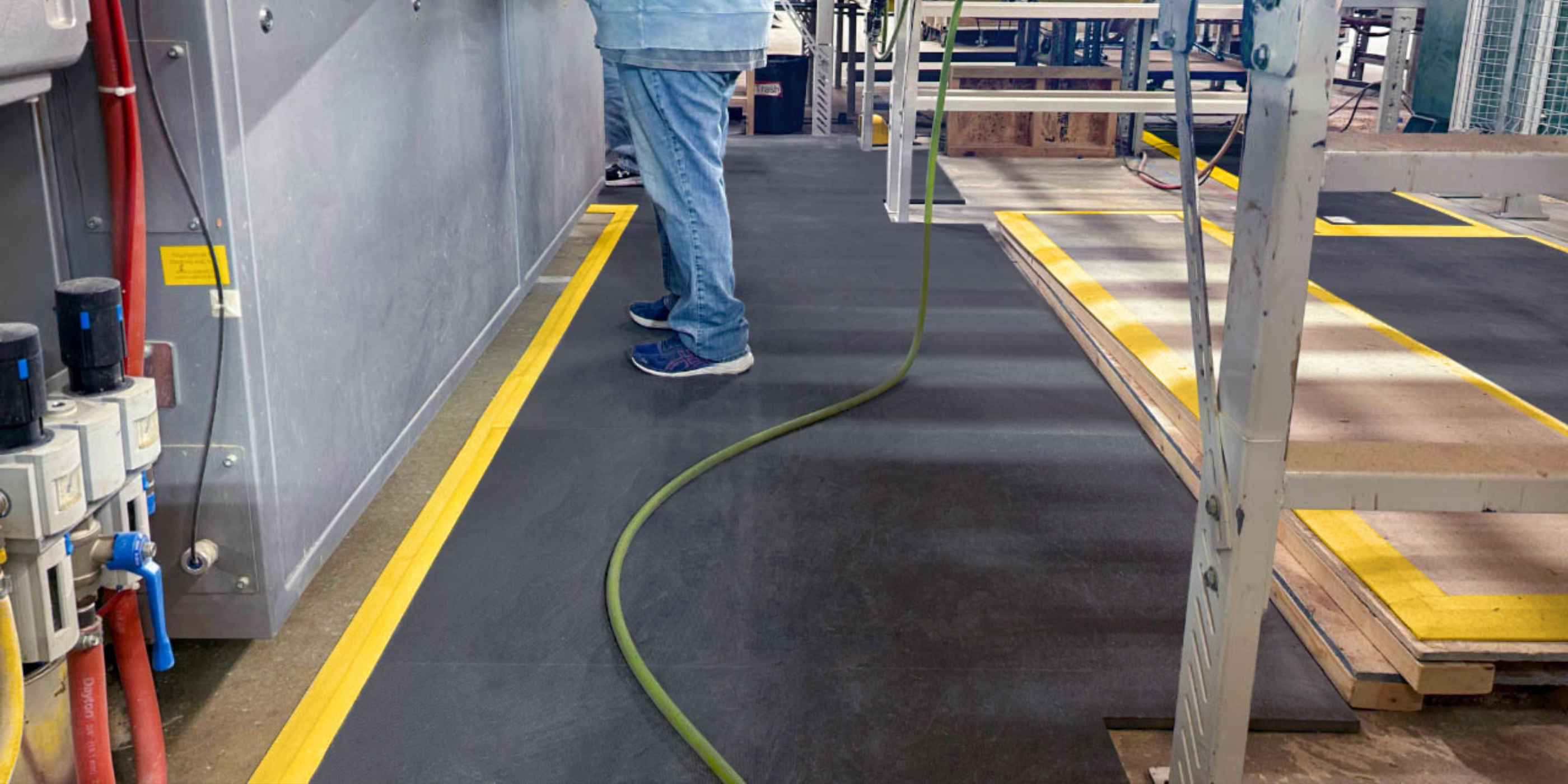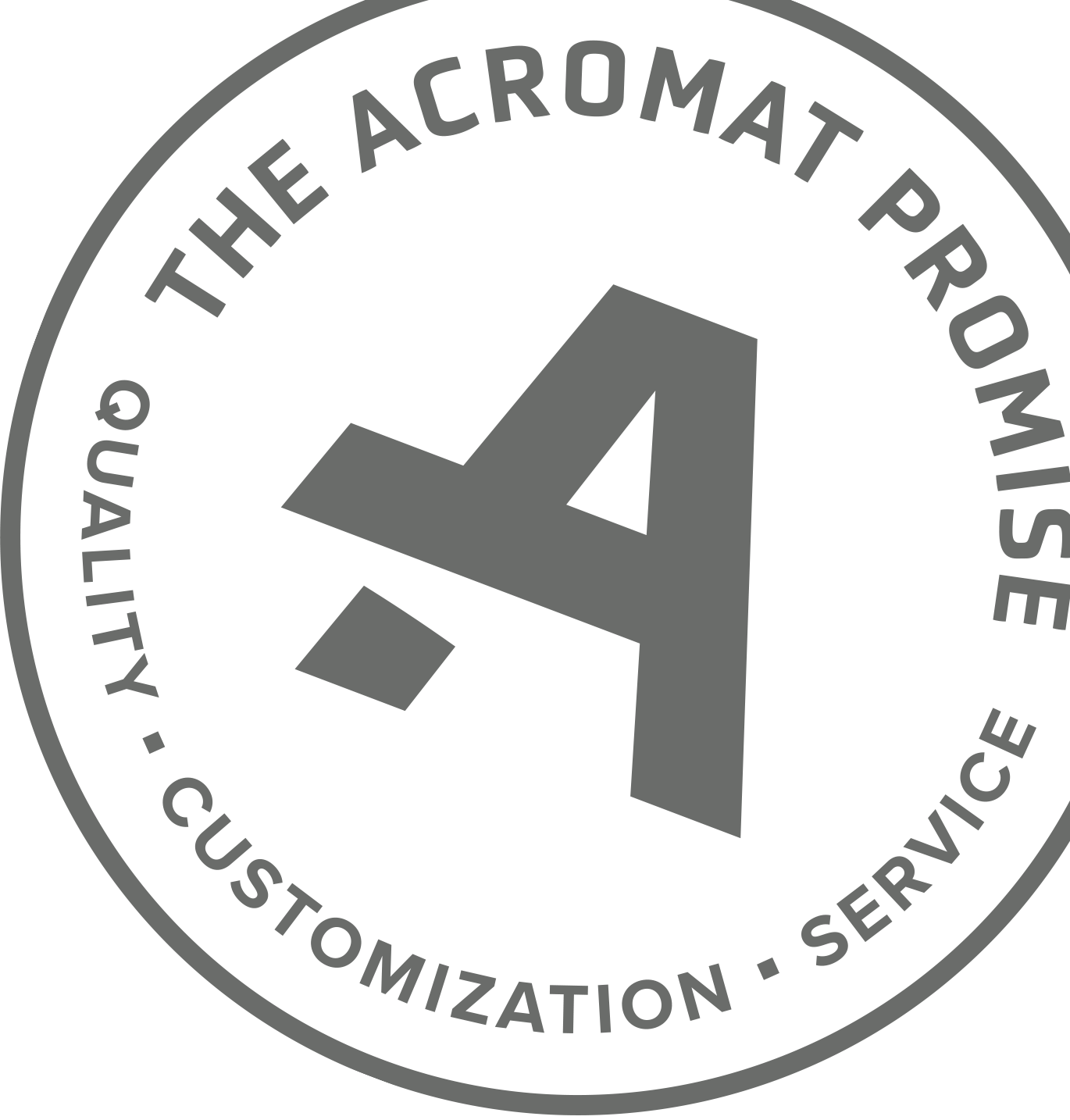Nitrile anti-fatigue mats reduce lower back pain and physical discomfort by as much as 50% compared to hard surfaces, while also reducing fall-related impacts by as much as 70%. They work by keeping your muscles engaged, promoting healthy blood flow, and helping your body share the load which reduces overexertion.
That's the short answer. The complete answer to "Do anti-fatigue mats work?" is more than a simple statistic. To understand if mats do in fact work, it’s important to look closely at how they work. Here are 6 ways anti-fatigue mats support injury prevention and workplace safety.
1. Anti-fatigue mats reduce pain and discomfort by 50%
MSDs are the leading cause of disability worldwide. Dr. Andrew Laing with the Centre of Research Expertise for the Prevention of MSDs (CRE-MSD) has spent over 10 years researching the development of MSDs and whether anti-fatigue mats can help prevent them.
He presented his team's findings during a March 2024 webinar – Anti-Fatigue Mats and Their Relationship to MSD Prevention – hosted by CRE-MSD.
As part of a study, Dr. Andrew's team had 16 adults over two days stand on hard surfaces (RIGID) for 60 minutes, followed by standing on a nitrile anti-fatigue mat (AFM) for 60 minutes. They looked closely at three areas: body posture, body movement, and pain or discomfort.
 Showing how Dr. Andrew measured posture, body movement and discomfort. Note, molded, closed cell, 100% nitrile is what we use to make our 100-Series mats here at AcroMat.
Showing how Dr. Andrew measured posture, body movement and discomfort. Note, molded, closed cell, 100% nitrile is what we use to make our 100-Series mats here at AcroMat.
Eight of the individuals were considered “pain developers” (PDs) – meaning they become physically uncomfortable in less than 60 minutes standing. The other eight were “non-pain developers (NPDs)” – meaning they can comfortably stand for 60 minutes.
The eight pain developers experienced a 50% reduction in lower back pain and physical discomfort standing on the nitrile mat (AFM) compared to the hard surface (RIGID).

"Those pre-disposed to pain experienced significant relief when standing on the anti-fatigue compared to RIGID floor,” shared Dr. Andrew. In brief, the 8 pain developers experienced a 50% decrease in physical discomfort when standing on a nitrile mat.
According to Dr. Andrew's research, roughly 30-50% of the world's population (2.4-4 billion) are pain developers and would benefit from using anti-fatigue mats over hard surfaces.
2. Anti-fatigue mats prevent static positions
MSD injuries often develop when we're in static positions for extended periods of time. When static, the same muscle tissues are loaded, there is a pooling of fluid in our lower limbs along with a build-up of metabolic waste, and each of these collectively contribute to the development of pain in our muscles and joints.
In short, prolonged pain leads to the development of recordable MSD injuries.
Conversely, anti-fatigue mats create subtle instabilities that keep our joins warm and prevent static standing. These slight movements help our bodies share tissue loading between muscles, force our muscles to remain engaged to keep us balanced, and create consistent muscle pumps.
According to Dr. Andrew's research, and our work with occupational therapists and injury prevention specialists, anti-fatigue mats prevent static standing in 4 key ways:
- Anti-fatigue mats decrease static positioning by consistently, though subtly, activating the muscles – reducing risks of locked limbs and stiffness.
- Anti-fatigue mats prevent the same muscle tissues from being loaded, reducing the risk of overexertion in any one area. Stated more simply, they help your body "share the load."
- Anti-fatigue mats prevent pooling of fluids in our lower limbs and encourage healthy blood flow to/from the heart, reducing the risk of painful varicose veins and similar issues.
- Anti-fatigue mats decrease the buildup of metabolic waste, reducing risks of pain, discomfort and ultimately recordable MSD injuries.
 Anti-fatigue mats soften joint impact, keep your muscles warm and engaged, and encourage healthy blood flow – all of which contribute to the 50% decrease in pain and a reduction of recordable MSD injuries.
Anti-fatigue mats soften joint impact, keep your muscles warm and engaged, and encourage healthy blood flow – all of which contribute to the 50% decrease in pain and a reduction of recordable MSD injuries.
AcroMat anti-fatigue mats contribute to the benefits above by being guaranteed and warrantied to never sink, flatten, or lose their ergonomic cushion. View our Lifetime Warranty, here.
Related: AcroMat Dynamic Fatigue Testing By OSHA-Accredited Lab
3. Anti-fatigue mats don't make you less tired
Anti-fatigue mats don’t actually make you less fatigued; we all get tired when working on our feet for hours at a time regardless of what's beneath our feet. However, as described in more detail above, they do reduce pain and discomfort which in turn helps prevent injury and increased productivity and output.
Proven ergonomic support keeps you healthier, stronger, and more physically and mentally available at work and home. This is where "anti-fatigue" is derived from.
One important key is finding a material that will not sink or flatten underfoot. For example, PVC foam, the most common ergo mat material, flattens over time because it is open cell and extruded. Conversely, 100% nitrile rubber foam, never sinks or flattens.

In addition to being guaranteed to never sink or flatten, the AcroMat 100-Series mats are also guaranteed to never curl – eliminating a dangerous and highly common trip hazard.
Employees at Titans of CNC , a CNC machining training company that reaches 190+ countries, share how their AcroMat anti-fatigue mats have reduced pain and discomfort in a way that has elevated productivity at their state-of-the-art facility in Dallas.
4. Anti-fatigue mats that are too soft can reduce balance
Have you noticed when standing how our bodies naturally sway? According to Dr. Andrew, this is our center of mass (COM) moving back and forth. The center of pressure (COP), under our feet, are the forces that come from the ground into our body. We use the COP to try and control COM, which keep us upright and balanced.
In brief, our bodies work hard to keep us balanced. The right mat materials complement and encourage this natural sway by keeping your body active and engaged. However, mats that are too soft, too thick, or if you're stacking your mats, they can work against your ability to remain balanced – increasing the rate of fatigue in addition to slip, trip, and fall risks.
Before making any major investments, look closely at warranty protections to make sure they are guaranteed not to bottom out, test a free sample mat in your facility, and review the durometer rating or shore hardness to confirm the balance of cushion.
 Stacking your anti-fatigue mats can increase "postural instability similar to standing in high heels for hours" and increase the risk of rolled ankles, says Ergonomist Mary Plehal.
Stacking your anti-fatigue mats can increase "postural instability similar to standing in high heels for hours" and increase the risk of rolled ankles, says Ergonomist Mary Plehal.
Ergonomist Crystal Nelson and AcroMat General Manager Russell Herbert discuss the ideal anti-fatigue mat thickness and whether your mats can be too soft. According to Crystal, between 5/8" and 3/4" is the ideal thickness for posture and traction.
5. Anti-fatigue mats reduce impact injuries by 70%
Anti-fatigue mats offer more than just ergonomic support; they reduce impact injury risks compared to falling on hard surfaces like cement, wood and metal. According to Dr. Andrew's research from the webinar:
- Falling on a nitrile anti-fatigue mat reduces hip impact by up to 50%.
- Falling on a nitrile anti-fatigue mat reduces head impact by up to 70%.
This is one reason why, here at AcroMat, a custom anti-fatigue mat manufacturer, "custom" means any shape and size and why we often cover entire workstations with one-piece designs. Custom mats not only cushion every step and provide NFSI "High Certified" Traction, but they reduce impact if there ever is a fall.
This 1,000+ sq. ft. custom nitrile anti-fatigue mat is providing this Fortune 500 automotive manufacturer with seamless ergonomic support, traction, and has created a soft landing if someone falls or drops vulnerable equipment.
6. Anti-fatigue mats are more effective than insoles
Dr. Andrew's team found "moderate" evidence that anti-fatigue mats help reduce pain, especially for the 30-50% of standing workers worldwide who are prone to discomfort when standing ("pain developers").
Comparatively, his team found “very limited” evidence insoles do the same. In fact, Dr. Andrew noted how “impacting the geometry of the shoe” – e.g., raising the foot too far from the shoe base with an insole – may increase the risk of slips, trips and falls because you’re less in control of your balance.
Amanda Eskew, EHS Specialist with Nokian Tyres, discusses why her team upgrades insoles to AcroMat anti-fatigue mats – including performance, comfort, and fully customizable capabilities. Find the full case study here.
Conclusion: Ask, listen, and document
True value from anti-fatigue mats is unique to the individual, their health history and body composition. If considering anti-fatigue mats, it’s critical to find the right size, shape and material for you/your people rather than leaning on broad claims.
There are a few simple steps you can take to get started:
1. Talk to your people and watch them work. Ask questions like: What are your pain levels at the end of a shift compared to the beginning? What would you change about your current mat? Are you constantly stepping on/off your mat or standing on the edges?
2. Get free sample mats and put them to the test in your production environment, for weeks or months at a time. Make sure they have the durability you need to last without sinking or flattening. Ask an ergonomist or physical therapist for insight into softness/firmness.
3. Look for testing data. Research and testing data about your mat provider's product should be readily available for you to review and validate. For example, AcroMat's curl testing data from OSHA-accredited testing laboratory, CSA Group. If data isn't available, don't be afraid to ask directly about your performance and durability concerns.
4. Review your anti-fatigue mat warranties. Look closely at the fine print and be 100% certain of what they are actually protecting you from. Be weary of warranties that don't cover any "wear and tear" or lack performance guarantees. Make sure they protect against issues like compression, flattening, and curling.
Interested in comparing AcroMat's 100% nitrile mats to what you're currently using?
Put a free sample to the test: Get a free sample mat




